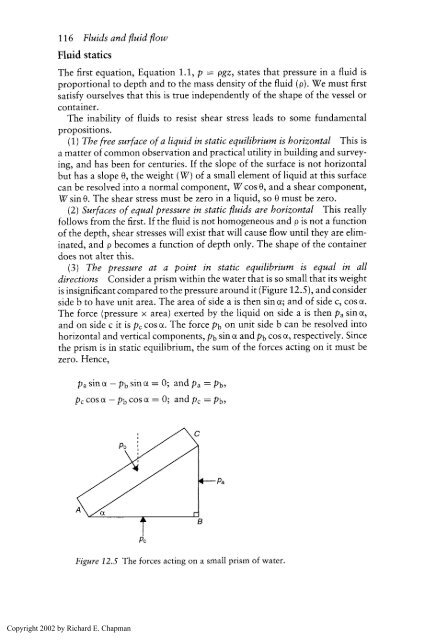Physics for Geologists, Second edition
Physics for Geologists, Second edition
Physics for Geologists, Second edition
Create successful ePaper yourself
Turn your PDF publications into a flip-book with our unique Google optimized e-Paper software.
116 Fluids and fluid flow<br />
Fluid statics<br />
The first equation, Equation 1.1, p = pgz, states that pressure in a fluid is<br />
proportional to depth and to the mass density of the fluid (p). We must first<br />
satisfy ourselves that this is true independently of the shape of the vessel or<br />
container.<br />
The inability of fluids to resist shear stress leads to some fundamental<br />
propositions.<br />
(1) The free surface of a liquid in static equilibrium is horizontal This is<br />
a matter of common observation and practical utility in building and survey-<br />
ing, and has been <strong>for</strong> centuries. If the slope of the surface is not horizontal<br />
but has a slope 0, the weight ( W) of a small element of liquid at this surface<br />
can be resolved into a normal component, W cos 0, and a shear component,<br />
W sin 0. The shear stress must be zero in a liquid, so 0 must be zero.<br />
(2) Surfaces of equal pressure in static fluids are horizontal This really<br />
follows from the first. If the fluid is not homogeneous and p is not a function<br />
of the depth, shear stresses will exist that will cause flow until they are elim-<br />
inated, and p becomes a function of depth only. The shape of the container<br />
does not alter this.<br />
(3) The pressure at a point in static equilibrium is equal in all<br />
directions Consider a prism within the water that is so small that its weight<br />
is insignificant compared to the pressure around it (Figure 12.5), and consider<br />
side b to have unit area. The area of side a is then sin a; and of side c, cos a.<br />
The <strong>for</strong>ce (pressure x area) exerted by the liquid on side a is then pa sina,<br />
and on side c it is p, cos a. The <strong>for</strong>ce pb on unit side b can be resolved into<br />
horizontal and vertical components, pb sin ct and pb cos a, respectively. Since<br />
the prism is in static equilibrium, the sum of the <strong>for</strong>ces acting on it must be<br />
zero. Hence,<br />
Copyright 2002 by Richard E. Chapman<br />
pa sin a - pb sina = 0; and pa = pb,<br />
p,cosa-pbcosa=O; andp, =pb,<br />
A<br />
Figure 12.5 The <strong>for</strong>ces acting on a small prism of water.






